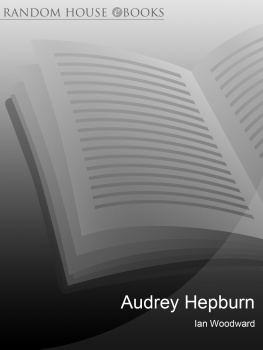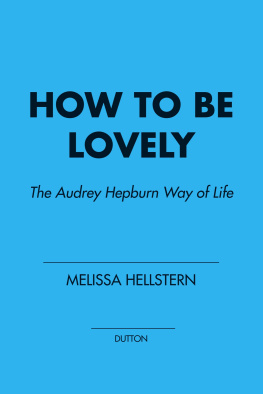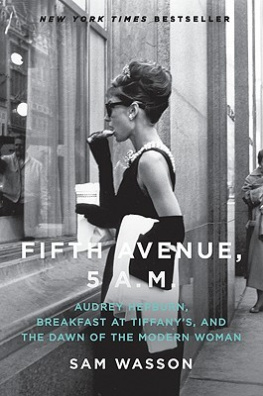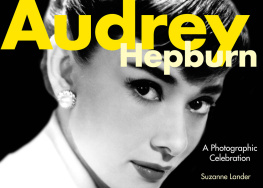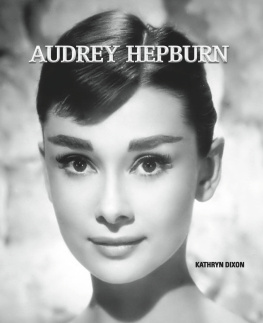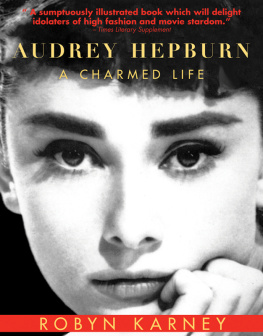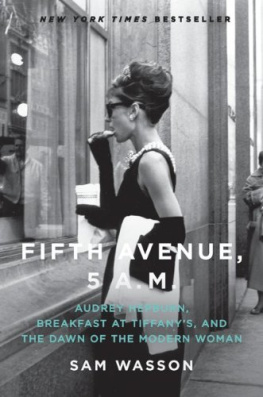Contents
About the Book
In this first major study of the captivating life of Audrey Hepburn. Ian Woodward uncovers the truly sensational story of one of Hollywood's most enduring legends.
Born into the Dutch aristocracy, Audrey Hepburn lived a fairy-tale existence until the outbreak of World War ll when her father, a Nazi sympathiser, abondoned his wife and children. Having risked her life for the Dutch resistance movement, she fled to England to train as a dancer.
But success came later when she was discovered in France by the novelist Colette, who realised she would be perfect for the character Gigi, and indeed, Audrey stunned both the ruthless New York critics and the public in Gigi on Broadway. Then came Roman Holiday, the film which brought her an Oscar and launched her international career in a string of movie successes like Funny Face, Breakfast at Tiffany's and My Fair Lady.
But even her illustrious film career paled against the outstanding work she did for UNICEF. Despite her personal fight against cancer, she dedicated the last years of her life to bringing help to the starving children of the world.
Audrey Hepburn became more than a movie star. She became a legend, first on screen and then on the arid plains of Africa.
About the Author
Ian Woodward is a writer specialising in show business. His feature articles appear regularly in newspapers and magazines worldwide, and his many books have been translated into German, French, Dutch, Spanish, Indonesian, Arabic and Japanese. He is also the author of Glenda Jackson: A Study in Fire and Ice. He lives with his wife Zenka and their two children, Philip and Stefanie, in Kings Langley, Hertfordshire, and in a fishing village in southern Spain.
Other books by Ian Woodward
Glenda Jackson: A Study in Fire and Ice
The Story of Clowns
The Werewolf Delusion
An AZ of Monsters
Balletgoing
Ballet and the Dance
Spotlight on Ballet
Teach Yourself Ballet
Ballet
Understanding Ballet
Dance
Birds in the Garden
Caring for Cage Birds
Pony Stories
Ballet Stories
Football Stories
Lives of the Great Composers (3 books)
Viewpoints
Los Grandes Temas de la Msica Clsica
Poetry (with Zenka Woodward)
Strolling Players
Thrills and Spills
The Beaver Book of Creepy Verse
Spine Tinglers
Poems for Fun
Comic and Curious Verse
Witches Brew
Poems for Christmas
Poems That Go Bump in the Night
There Are Monsters About
One Hundred Favourite Poems
Ring Out Wild Bells
The Howling Pandemonium
Audrey Hepburn
Fair Lady of the Screen
Ian Woodward

Picture Credits
The quintessential Audrey Hepburn as Maurice Chevaliers daughter in the sex comedy Love in the Afternoon (Allied Artists)
Audrey and Valentina Cortesa in The Secret People (Ealing/Lippert)
With her mother, the Baroness Ella van Heemstra (Associated Press)
With her first husband, Mel Ferrer, arriving at London Airport, 15 November 1956 (Popperfoto)
With husband number two, Dr Andrea Dotti, on their wedding day, 18 January 1969 (Popperfoto)
In Roman Holiday, for which she won an Oscar (Paramount)
With co-star Humphrey Bogart in Sabrina (Paramount)
As Natasha, with Mel Ferrer as Prince Andrey, in War and Peace (Paramount)
Audrey, James Garner and Shirley MacLaine in a publicity photograph for The Childrens Hour (United Artists)
As Holly Golightly in Breakfast at Tiffanys (Paramount)
In John Hustons The Unforgiven (United Artists)
As Eliza Doolittle, with Jeremy Brett in My Fair Lady (Warner Bros/CBS)
Audreys sons Luca and Sean, and her companion Rob Wolders, at her funeral on 24 January 1992 (Popperfoto)
Audreys favourite portrait of herself in her capacity as UNICEF Goodwill Ambassador, with a child in Ethiopia in 1988 (Popperfoto)
Hepburn on Hepburn
My life isnt theories and formulae. Its part instinct, part common sense. Logic is as good a word as any, and Ive absorbed what logic I have from everything and everyone... from my mother, from training as a ballet dancer, from Vogue magazine, from the laws of life and health and nature.
I tried always to do better: saw always a little further. I tried to stretch myself.
I went through a period of first success. Then there was the inevitable change: the bad newspaper articles. Some people dont care about that, but I do. Im hurt. I feel it. I dont think Ive done anything dreadful. Sometimes you do things for reasons the press doesnt know. But Im happy to go on as I have.
I never read articles about me because it makes me nervous to know what others think of me. I used to suffer so from gossip columns. Theres never been a helluva lot to say about me...
Preface
There must be something wrong with those people who think Audrey Hepburn doesnt perspire, hiccup or sneeze, because they know thats not true. In fact, I hiccup more than most.
In the entire star-studded history of Hollywood, no other screen goddess held herself so aloof from the standard public trivialities of superstardom as Audrey Hepburn. She never flaunted her sex or her glamour trappings. Although she owned no yachts or castles, she was a multi-millionairess who lived like work-a-day royalty: almost from the beginning, Frank Sinatra dubbed her the Princess. Yet she travelled all over the world, latterly as goodwill ambassador of UNICEF, with less fanfare than a junior starlet. She probably took more luxury flights than any member of the jet set. She was never known to lend herself to stunts which could conceivably further her career. She broke, in short, all the rules of how to succeed in Hollywood.
By any standards, her journey from the back row of a London chorus to the front rank of Hollywood stars and Broadway leading ladies was a phenomenal one, and it could only have happened to Audrey Hepburn. Her leading men included Sean Connery, Robert Wagner, Richard Dreyfuss, Albert Finney, Ben Gazzara, Gregory Peck, William Holden, Humphrey Bogart, Henry Fonda, Fred Astaire, Gary Cooper, Anthony Perkins, Peter Finch, Burt Lancaster, George Peppard, James Garner, Cary Grant, Rex Harrison and Peter OToole. None but the best for this Anglo-Dutch waif.
Audrey managed to portray in most of her screen characters women of spectacular elegance, groomed, rich and lovely; yet very much more than cardboard cut-outs. She was long dressed by Givenchy. But, for Audrey, the haute couture, the polish and the squeaky-clean qualities with which most of her characterisations were endowed became simply accessories to an acting talent of stained-glass brilliance. Along the way, with those huge eyes, engaging, elfin smile, long neck and barest covering of flesh over her splendid bones, she was always a fashion photographers dream: Audrey Hepburn and Richard Avedon were a natural combination.
She radiated a fragile, sparrowish beauty which won admiration without either giving or receiving menace. Not for her the husky forcefulness of Lauren Bacall, the provocative artifice of Marilyn Monroe, the dizzy panache of Shirley MacLaine. Her appeal lay precisely in the fact that she never set herself up as a sex symbol and laid no claim to the crown of a screen goddess. She was, as someone observes in Funny Face, a bird of paradise. She was a lightener of hearts. But was there also something more to her, something we missed?
Next page
